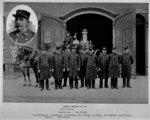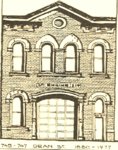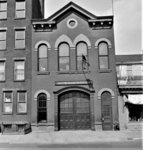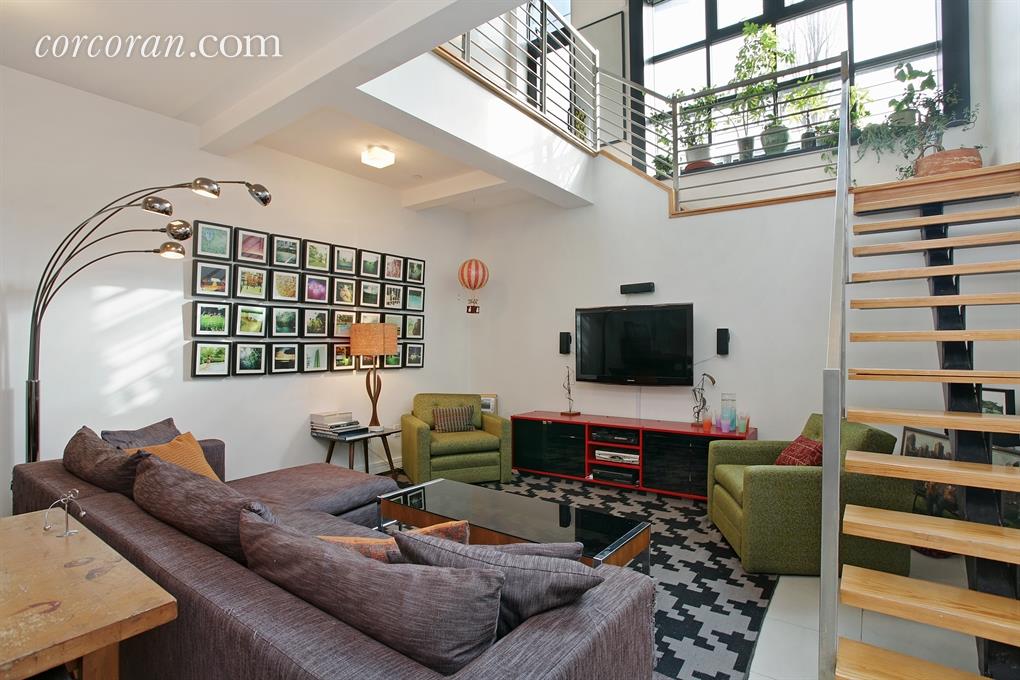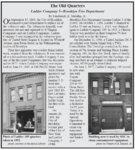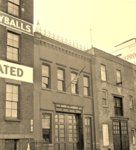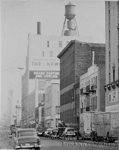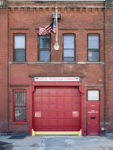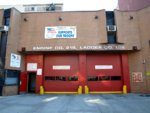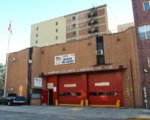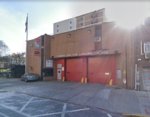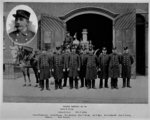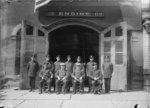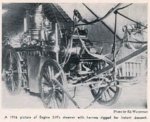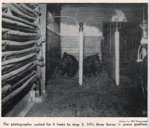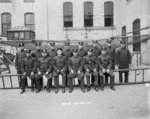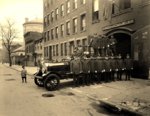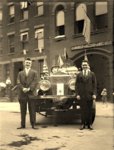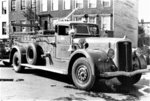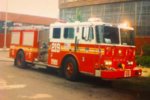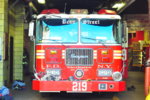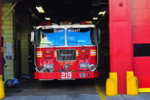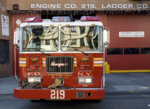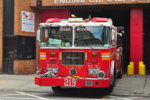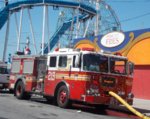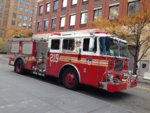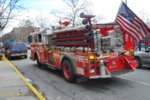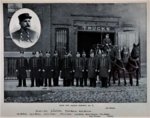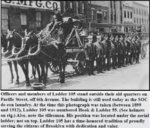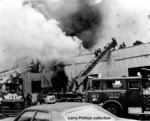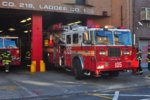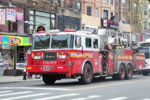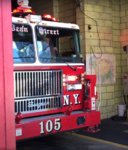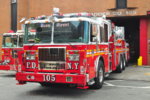Engine 219/Ladder 105 (continued)
Pre-FDNY Brooklyn Fire Department:
Ladder 5 BFD:
"HOOK AND LADDER COMPANY NO. 5 : HEROES OF MANY "CLOSE SHAVES"

Hook and Ladder Company No. 5 was organized by Fire Commissioner Richard H. POILLON, on June 15, 1885. It is located in Pacific Street near Sixth Avenue, in the centre of a very important district which is bounded by DeKalb Avenue, Nostrand Avenue, Fifth Street and Bond Street. There are seventy boxes in this district, and on a second-alarm the company responds to sixty-five additional boxes. In this district are Graves' furniture house, Green's underwear factory, Knox's hat factory. Kings County Penitentiary, Brooklyn watch case works; Ovington Brothers' crockery store, Journeay & Burnham's store, the Johnson building, Dyckman's box factory, Municipal Gas Company's works, Public Schools Nos. 9, 15, and 47, St. Joseph's parochial school, Talmage's Tabernacle, Washington Avenue Baptist church, St. Joseph's Roman Catholic, St. Luke's Episcopal, Dr. Cuyler' s church, Lafayette Avenue Congregational, St. Augustine's and Frs. McCarty, McNamee and Corcoran's churches, the 13th Regiment Armory, the Long Island R. R. passenger and freight depots. Young Women's Christian Association, Seney Hospital, Long Island Brewery, Budweiser brewery, Webster's silver-plating factory, Schieber's silver-plating factory, Tivoli Hall and the Franklin Avenue car stables.
The company has a second-class Hayes truck and three handsome, well-trained horses, "Dan," a sorrel, "Baby" a dark iron-gray, and "Charlie Hart," a brown. They have a full-blooded English coach-dog, which is called "Frances," after Mrs. Cleveland. Frances is as intelligent as she is handsome, and prior to being run over by the truck in 1888, when one of her legs was broken, it was customary for her to go out with the truck on every alarm, and when the fire was reached to follow the men up to the roof. Since that event Frances has been detailed on the house watch, and it is as much as a man’s life is worth to try to enter the house when the company is out.
There are quite a number of men in the company who have been with it since its organization, and as such they have seen many fires which required many hours of hard and perilous work to subdue. Notable among these were Watson's stores, the Penitentiary shoe shop, Adelphi Academy, Planet Mills, Talmage’s Tabernacle, the Seventh Avenue car stables, Brasher's oilcloth works. Butler Street car stables. Watts- lumber yard. Hyde & Behman's theatre, Poillon’s ship yard, Loomis' moulding mills, the Hulvert mansion, Bradley's carpet house, Messuli's paint works and the Sand Street flathouse fires.
Foreman THOMAS HEALEY has had several narrow escapes since he became a Member of the Department on Dec. 6, 1870. The closest "shave" he ever had was when he walked off the dock during the fire at Watson's stores and sank in twelve feet of water. When he came up his fire-hat was gone, and being weighted down with his rubber coat and boots he found it extremely difficult to swim to the dock. The boys succeeded in getting him out with a rope just as his strength was deserting him. At the fire at Woodruff & Robinson's stores, Mr. HEALY with others was on the roof when it fell in and precipitated them a distance of fifteen feet into a bin of burning grain, from which they were extricated with great difficulty. At the Pratt's oil works fire he made his best running record while trying to keep ahead of a river of burning oil. Mr. HEALY was born in the County Roscommon. Ireland, July 18. 1841, and was educated at the common schools of his native town. When he came to Brooklyn, he joined Goodwill Engine Company No. 4 and ran with her until the disbandment of the Volunteer Department. His first fire duty in the new Department was with Truck No. 2. He was afterward transferred to Engine No. 19 and then to Truck No. 6. While with the latter company, on Sept. 5, 1885, he was promoted to the grade of Foreman and placed in command of Engine Company No. 9, and from that company was transferred to his present command.
Assistant Foreman MARTIN J. CORCORAN was among the first to be promoted when Commissioner ENNIS created that rank. He was born in the city of Limerick, Dec. 5, 1860, and was educated on his native heath. He was appointed to the uniformed force on Jan. 30, 1882, and assigned to Engine Company No. 19, and later was detailed as driver for District Engineer Parley. He was a private in Truck No. 5 at the time of his promotion on March 1, 1887. Mr. CORCORAN has been injured many times in discharge of his duty. While a private in Engine Company No. 19, in Aug. 1883, he was so ill with malaria that the Department surgeon advised him not to do active duty for a time. A fire broke out on a very hot day and Mr. CORCORAN, disregarding the doctor's advice, went out with his company. He was stationed on the wall of an adjoining building when he was overcome with the heat and fell backward, injuring his head so badly that it was necessary to remove him to the Homeopathic Hospital, where he remained for several days. He narrowly escaped being killed at the Portland Avenue flat-house fire, when. one of the ceilings fell on him and others, and nearly buried them under a mass of burning timbers. At another time one of the horses belonging to Engine No. 19 threw him and nearly fractured his skull. At "The Abbey " fire, Mr. CORCORAN sprained his ankle so seriously that he was laid up for six weeks, and at a laid at Raymond and Fulton Streets his shoulder was nearly wrenched out of the socket.
JOHN H. HINTON, the driver of the apparatus, was born in New York City, Oct. 27, 1848. When he was appointed a member of the Paid Department he was assigned to duty with Truck No. 1. He was later transferred to Engine No. 20, then to the Veterinary Department, back to Truck No. 1, then to Engine No. 3, from there to Engine No. 24, and then to this company. At the ink factory fire on' Forty-second Street, South Brooklyn, in 1882, he with three other firemen narrowly escaped being killed by the caving in of the roof on which they were standing.
WILLIAM H. JONES, the tillerman, is one of the life-savers of the Department. "While tillerman of Truck No. 1, he assisted Engineer Duff, then Foreman of Engine No. 3, in bringing out an unconscious woman from the first floor of a dwelling on Columbia, near Congress Street. In Feb. 1887, unaided and with no little peril to himself, he carried a woman from the third floor of a burning house on Fifth Avenue, down the stairway to the street. Besides being suffocated she had inhaled fire, and she died at the City Hospital some hours later. Mr. JONES was born in Brooklyn, Nov. 2, 1849. In July, 1875, he enlisted in the regular army, where he served for five years with the 9th Infantry. His appointment to the Department was made on Jan. 30, 1882.
MICHAEL JOSEPH KELLEY was born in Manchester, England, Jan. 15, 1857, and he has been a member of Truck No. 5 since he was appointed to the uniformed force, on Dec. 10, 1891.
LOUIS SCHULZ was born in New Hyde Park, L. I., on the anniversary of Washington's Birthday, 1866. He enlisted in the United States Navy May 23,1887, and received an honorable discharge together with a continued service certificate June 12, 1890. Commissioner ENNIS made him a fireman Nov. 16. 1891, and he has been with Truck No. 5 since that time.
EDWARD PATRICK COFFEY was born in the city of Dublin, Ireland, Feb. 14, 1864. He was made a fireman Aug. 1, 1889, and since that time has done duty with Engines Nos. 14, and 27 and Truck No. 5.
JOHN L. TUCKER was born in Brooklyn, July 24,1860, and became a member of the Department June 4, 1890.
JAMES J. McGARRY was born in Brooklyn, March 18, 1859, and he has worn the uniform with credit to himself and the Department since July 17, 1891.
JAMES A. MALONE was a member of Mount Hose No. 10 when the Volunteer Department was disbanded. He was born in Brooklyn in 1847, and during the Civil War fought under General " Phil" Sheridan. He was appointed to the new Department Jan. 29, 1870 and assigned to duty with Engine No. 10, where he remained for fifteen years. He was then transferred to Engine No. 19, then to Engine No. 6, and thence to Truck No. 5 at the time of its organization. While a member of Engine No. 10, the tender upset on the way to Loomis' moulding mill fire, and Mr. MALONE narrowly escaped being killed.
HENRY A. BRINKMAN has been a member of this company since its organization and has worn the uniform since Nov. 12. 1880. In 1883, while a member of Engine No. 4, he received internal and spinal injuries by the collapsing of a church on Third Avenue. Mr. BRINKMAN was born in Brooklyn. Aug. 18, 1855, and has proved himself to be not only a good citizen but a faithful member of the Department. The orders have been issued and preparations have been made for the organization of a new engine-company, No. 34, to be attached to the Eighth District. Its house, now building, will be on Bergen Street, east of Troy Avenue.
- from "Our Firemen- the History of the Brooklyn Fire Department"



